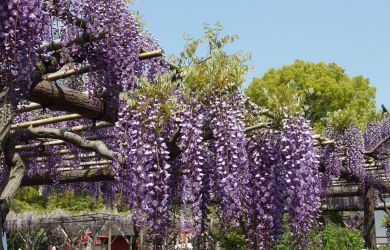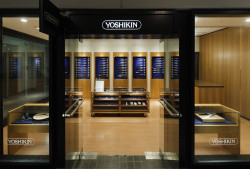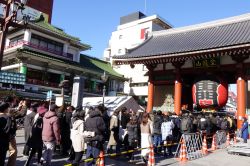
August 15, 2008
The Old Kiso Road
Tread in the footsteps of Edo-era travelers, and sleep where they slept
By Metropolis
Originally published on metropolis.co.jp on August 2008

Photos by Leanne Mumford
Tokugawa Ieyasu designated the Nakasendo, or “central mountain road,” one of Japan’s five official highways in 1602. On this route stretching from Kyoto to Edo (now Tokyo) were 69 post towns. Three of these best preserved villages—Narai, Tsumago and Magome—are located along the Kiso River valley, making for a beautiful hike through history.
Narai, at the foot of the challenging Torii-toge pass, was known as “the town of 1,000 inns,” though in reality there were fewer. One was designated for use by the daimyo (feudal lord), another for lower-ranked officials, and others for ordinary travelers. It’s still possible to stay at several of the original inns.
From Narai railway station, the town’s historic main street extends for about 1km, lined on both sides by two-story dark timber buildings. Some have display windows and open doors, through which lacquerware and other handicrafts are visible. Others have thin latticework covering the windows. Signs advertise handmade soba noodles. In between the buildings, narrow lanes lead off to temples and shrines, and the structures seem to almost reach out towards each other across the street. At five places, spring water is fed to covered traditional drinking fountains, which are still provided with water scoops for use by thirsty travelers, just as in centuries past. No power lines or even streetlights are present to detract from the traditional architecture. Vehicles are allowed, but the modern highway bypasses the town and traffic is light.
Our group of five booked two rooms at the 190-year-old Iseya inn, which once provided horse and porter service. The once earthen-floored entranceway of the main building is now tiled, but waxed paper umbrellas still hang inside ready for guests to borrow. We were excited to be shown upstairs to two of the four original guest rooms. The old floorboards in the corridor were warped and creaky, and our rooms had lattice-covered windows looking out onto the street. We drank tea around a lacquered table and marveled at staying in rooms where travelers had been stopping to rest for nearly 200 years.
Before dinner we strolled along the street as the day-trippers departed. A traditional cedar ball was hung over the entrance of the Sugi no Mori brewery, where we tasted sake made on the premises. As dusk descended, paper lanterns shone softly outside each building. Back at Iseya, dinner was served in the long, narrow dining room on the ground floor. Featuring mountain vegetables and freshwater fish, the dishes were full of distinct and delicious flavors. We all ate far too much.
The next morning, nourished by a substantial breakfast, we bid farewell to Iseya’s proprietor and set off to walk a section of Kiso Kaido. The route over Torii-toge pass follows a narrow, often steep footpath through dense forest. A section not far from Narai and another near the next post town, Yabuhara, are paved with stones, known as ishidatami, which must have been difficult in bad weather for Edo-era travelers in straw rope sandals. Climbing to the pass, we crossed rickety bridges over fast-flowing streams. Frogs croaked and birds called. Distant mountains were occasionally visible. The route has huts for resting and wells for drinking, and two buildings with public toilets are also maintained.
On the Yabuhara side, brass bells have been erected at three points. Walkers are encouraged to ring them to warn off any bears that may be around. Fortunately we didn’t encounter any in our three-hour walk from Narai to Yabuhara. The train back to Narai takes only six minutes.
Another section of the Kiso Road further down the valley links Tsumago and Magome. This popular walk also takes around three hours, but the trail passes through more varied landscape than that between Narai and Yabuhara. From Tsumago, with its white-walled storehouses and timber buildings, the route skirts some rice fields on the way to Oku-Tsumago. A slight detour leads to two waterfalls. The trail also passes by an old teahouse as it climbs through forest to Magome-toge pass. Then it descends through fields and small hamlets until reaching a steep, stone-paved street that winds downhill between the souvenir shops, restaurants and inns of Magome.
Neither Tsumago nor Magome allow vehicles in their main streets during the day. As in Narai, overhead wires are hidden away, and there are no convenience stores or other obvious symbols of modernity. In Tsumago, Magome and Narai, the slower pace of a bygone era beckons still along the old Kiso Road.
The Tokaido shinkansen provides a fast, convenient connection between Tokyo and Kyoto, but an alternate route via the Chuo line offers a slower, richer experience with echoes of the Edo period. The JR Chuo West line serves the Kiso Valley. Narai can be reached by local train from either Shiojiri or Kiso-Fukushima. Super Azusa Limited Express trains from Shinjuku to Shiojiri take about two-and-a-half hours. Some limited express trains running between Matsumoto and Nagoya stop at Nagiso; it’s then a few minutes by taxi or infrequent bus to Tsumago. Magome can be reached from Nakatsugawa station by bus in about 30min. Shinano limited express trains take about 50min from Nagoya to Nakatsugawa. Through Aug 31, there is a ¥500 baggage forwarding service available between Tsumago and Magome; the deadline is 11am. Further details about the hike are available in the JNTO publication Kiso Valley, available for download at http://tinyurl.com/jnto-kiso. A night’s stay at Iseya (www.oyado-iseya.jp) costs ¥8,500 per person including two meals. The English-language Japanese Guest Houses website (www.japaneseguesthouses.com/db/tsumago) lists several other ryokan and minshuku in the Kiso Valley.







